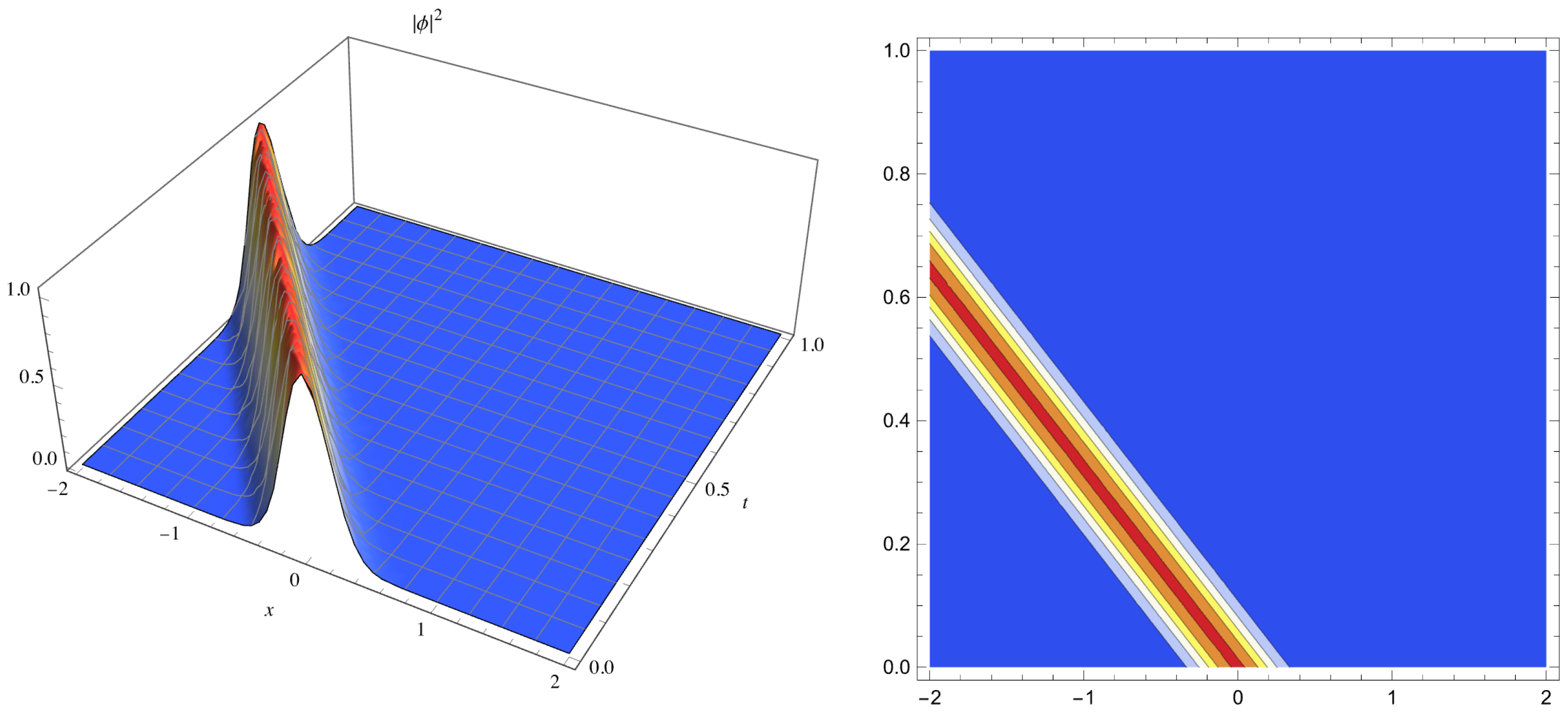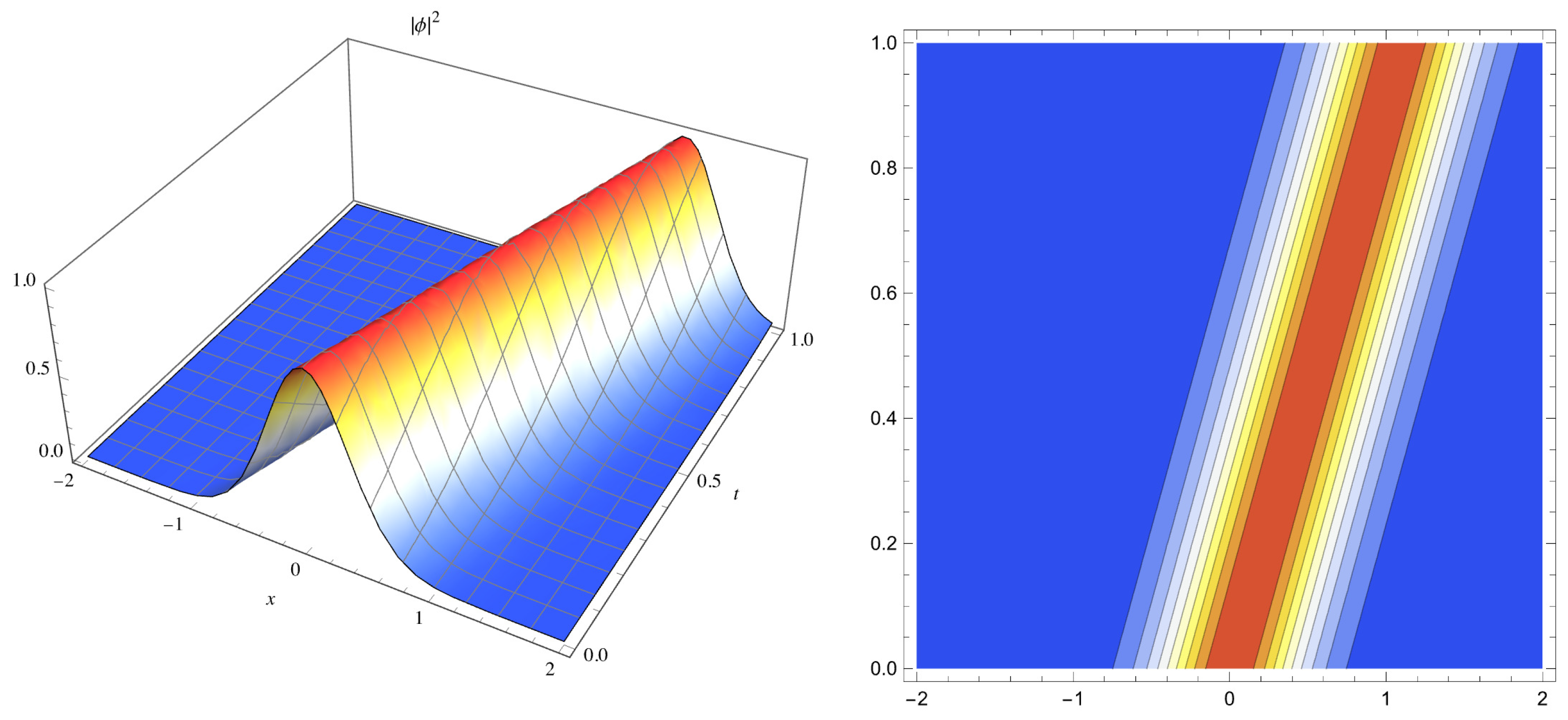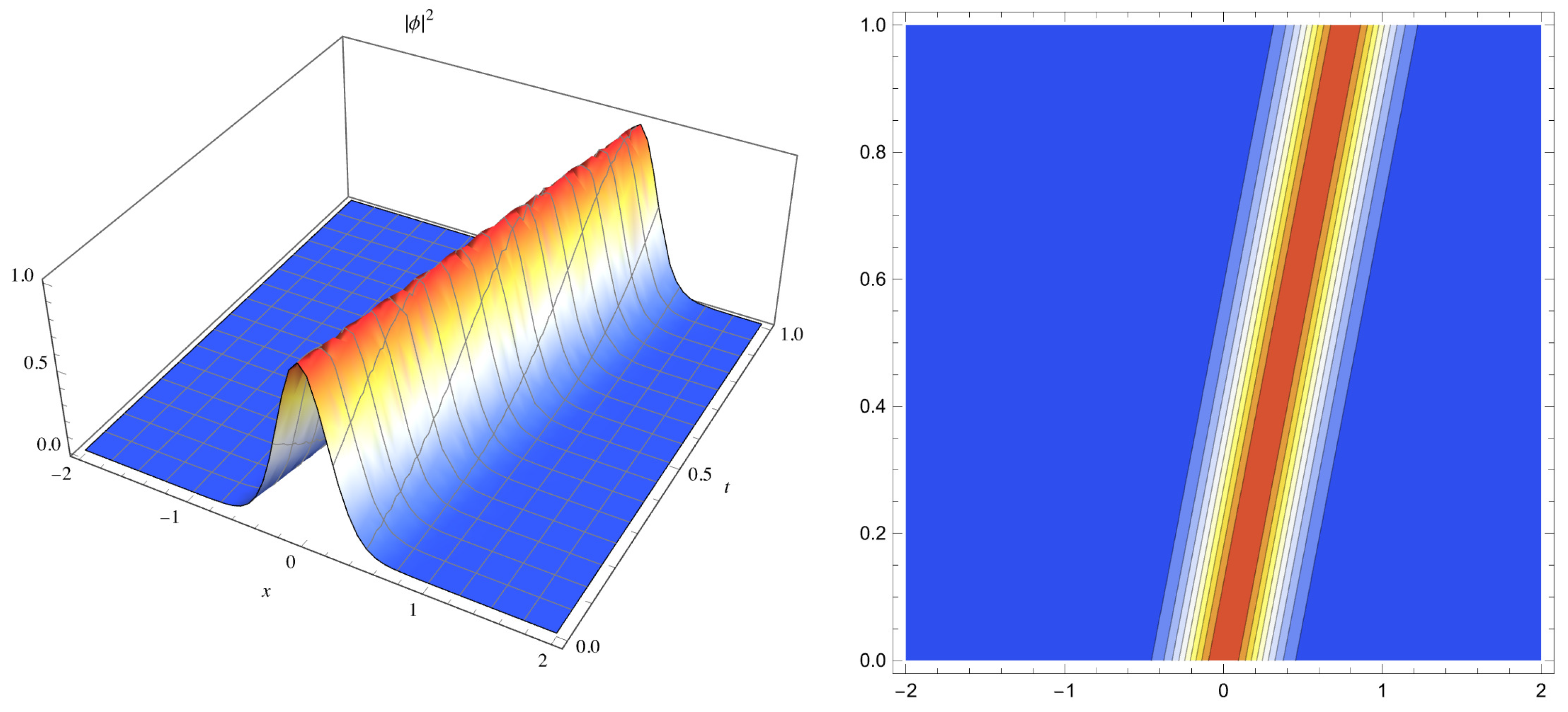Highly Dispersive Optical Soliton Perturbation for Complex Ginzburg–Landau Equation, Implementing Three Forms of Self-Phase Modulation Structures with Power Law via Semi-Inverse Variation
Abstract
1. Introduction
The Structure of the Complex Ginzburg–Landau Equation
2. Basic Mathematical Preliminaries
3. Application of the Semi-Inverse Variational Principle
3.1. Considering Power Law
3.2. Considering Dual-Power Law
3.3. Considering Triple-Power Law
4. Conclusions and Future Perspectives
Author Contributions
Funding
Institutional Review Board Statement
Informed Consent Statement
Data Availability Statement
Acknowledgments
Conflicts of Interest
References
- Biswas, A.; Berkemeyer, T.; Khan, S.; Moraru, L.; Yildirim, Y.; Alshehri, H.M. Highly dispersive optical soliton perturbation with maximum intensity, for the complex Ginzburg–Landau equation by semi–inverse variation. Mathematics 2022, 10, 987. [Google Scholar]
- Biswas, A.; Asma, M.; Guggilla, P.; Mullick, L.; Moraru, L.; Ekici, M.; Alzahrani, A.K.; Belic, M.R. Optical soliton perturbation with Kudryashov’s equation by semi–inverse variational principle. Phys. Lett. A 2020, 384, 126830. [Google Scholar]
- Biswas, A.; Ekici, M.; Dakova, A.; Khan, S.; Moshokoa, S.P.; Alshehri, H.M.; Belic, M.R. Highly dispersive optical soliton perturbation with Kudryashov’s sextic–power law nonlinear refractive index by semi–inverse variation. Results Phys. 2021, 27, 104539. [Google Scholar] [CrossRef]
- Gao, X.; Shi, J.; Belic, M.R.; Chen, J.; Li, J.; Zeng, L.; Zhu, X. W-shaped solitons under inhomogeneous self-defocusing Kerr nonlinearity. Ukr. J. Phys. Opt. 2024, 25, S1075–S1085. [Google Scholar]
- Biswas, A.; Dakova, A.; Khan, S.; Ekici, M.; Moraru, L.; Belic, M.R. Cubic–quartic optical soliton perturbation with Fokas–Lenells equation by semi–inverse variation. Semicond. Phys. Quantum Electron. Optoelectron. 2021, 24, 431–435. [Google Scholar] [CrossRef]
- Mihailović, D.T. Complexity in nonlinear and quantum optics by considering Kolmogorov derivatives and change complexity information measures. Trans. Opt. Photonics 2025, 1, 1–8. [Google Scholar]
- He, J.H. Semi–inverse method of establishing generalized variational principles for fluid mechanics with emphasis on turbomachinery aerodynamics. Int. J. Turbo Jet Engines 1997, 14, 23–28. [Google Scholar]
- He, J.H.; Sun, C. A variational principle for a thin film equation. J. Math. Chem. 2019, 57, 2075–2081. [Google Scholar] [CrossRef]
- He, J.H. Variational principle and periodic solution of the Kundu–Mukherjee–Naskar equation. Results Phys. 2020, 17, 103031. [Google Scholar]
- Kheir, H.; Jabbari, A.; Yildirim, A.; Alomari, A.K. He’s semi–inverse method for soliton solutions of Boussinesq system. World J. Model. Simul. 2013, 9, 3–13. [Google Scholar]
- Dakova-Mollova, A.; Miteva, P.; Slavchev, V.; Kovachev, K.; Kasapeteva, Z.; Dakova, D.; Kovachev, L. Propagation of broad-band optical pulses in dispersionless media. Ukr. J. Phys. Opt. 2024, 25, S1102–S1110. [Google Scholar] [CrossRef]
- Li, X.W.; Li, Y.; He, J.H. On the semi–inverse method and variational principle. Therm. Sci. 2013, 17, 1565–1568. [Google Scholar] [CrossRef]
- Libarir, K.; Zerarka, A. A semi–inverse variational method for generating the bound state energy eigenvalues in a quantum system: The Dirac Coulomb type–equation. J. Mod. Opt. 2018, 65, 987–993. [Google Scholar] [CrossRef]
- Liu, H.M. The variational principle for Yang–Mills equation by semi–inverse method. Facta Univ. Ser. Mech. Autom. Control Robot. 2004, 4, 169–171. [Google Scholar]
- Liu, W.Y.; Yu, Y.J.; Chen, L.D. Variational principles for Ginzburg–Landau equation by He’s semi–inverse method. Chaos Solitons Fractals 2007, 33, 1801–1803. [Google Scholar] [CrossRef]
- Ozis, T.; Yildirim, A. Application of He’s semi–inverse method to the nonlinear Schrodinger equation. Comput. Math. Appl. 2007, 54, 1039–1042. [Google Scholar] [CrossRef]
- Singh, S.S. Bright and dark 1—soliton solutions to perturbed Schrodinger—Hirota equation with power law nonlinearity via semi—inverse variation method and ansatz method. Int. J. Phys. Res. 2017, 5, 39–42. [Google Scholar] [CrossRef]
- Tao, Z.L. Solving the breaking soliton equation by He’s variational method. Comput. Math. Appl. 2009, 58, 2395–2397. [Google Scholar] [CrossRef][Green Version]
- Yan, W.; Liu, Q.; Zhu, C.M.; Zhao, Y.; Shi, Y. Semi–inverse method to the Klein–Gordon equation with quadratic nonlinearity. Appl. Comput. Electromagn. Soc. J. 2018, 33, 842–846. [Google Scholar][Green Version]
- Tang, L. Optical solitons perturbation for the concatenation system with power law nonlinearity. J. Opt. 2025, 54, 789–798. [Google Scholar] [CrossRef]
- Zhang, J.; Yu, J.Y.; Pan, N. Variational principles for nonlinear fiber optics. Chaos Solitons Fractals 2005, 24, 309–311. [Google Scholar] [CrossRef]
- Jawad, A.J.M.; Abu-AlShaeer, M.J. Highly dispersive optical solitons with cubic law and cubic–quintic–septic law nonlinearities by two methods. Al–J. Eng. Sci. 2023, 1, 1–8. [Google Scholar] [CrossRef]
- Jihad, N.; Almuhsan, M.A.A. Evaluation of impairment mitigations for optical fiber communications using dispersion compensation techniques. Al–J. Eng. Sci. 2023, 1, 81–92. [Google Scholar]
- Mendez-Zuniga, I.M.; Belyaeva, T.L.; Agüero, M.A.; Serkin, V.N. Multisoliton bound states in the fourth–order concatenation model of the nonlinear Schrödinger equation hierarchy. Trans. Opt. Photonics 2025, 1, 22–33. [Google Scholar]
- Polyanin, A.D.; Kudryashov, N.A. Nonlinear Schrödinger equations with delay: Closed–form and generalized separable solutions. Contemp. Math. 2024, 5, 5783–5794. [Google Scholar] [CrossRef]
- Sarkar, T.; Raut, S.; Mali, P.C. The classification of the exact single travelling wave solutions to the constant coefficient KP-mKP equation employing complete discrimination system for polynomial method. Comput. Math. Methods 2022, 22, 3844031. [Google Scholar] [CrossRef]
- Raut, S.; Saha, S.; Das, A.N.; Talukder, P. Complete discrimination system method for finding exact solutions, dynamical properties of combined Zakharsov-Kuznetsov-modified Zakarsov- Kuznetsov equation. Alex. Eng. J. 2023, 76, 247–257. [Google Scholar] [CrossRef]
- Rasoulizadeh, M.N.; Nikan, O.; Avazzadeh, Z. The impact of LRBF-FD on the solutions of the nonlinear regularized long wave equation. Math. Sci. 2021, 15, 365–376. [Google Scholar] [CrossRef]
- Babajanov, B.; Abdikarimov, F. Solitary and periodic wave solutions of the loaded Boussinesq and the loaded modified Boussinesq equation. J. Math. Comput. Sci. 2023, 30, 67–74. [Google Scholar] [CrossRef]
- Kasapeteva, Z. Energy exchange between the polarization components of an optical pulse under the influence of degenerate four-photon parametric processes. Trans. Opt. Photonics 2025, 1, 58–66. [Google Scholar]



Disclaimer/Publisher’s Note: The statements, opinions and data contained in all publications are solely those of the individual author(s) and contributor(s) and not of MDPI and/or the editor(s). MDPI and/or the editor(s) disclaim responsibility for any injury to people or property resulting from any ideas, methods, instructions or products referred to in the content. |
© 2025 by the authors. Licensee MDPI, Basel, Switzerland. This article is an open access article distributed under the terms and conditions of the Creative Commons Attribution (CC BY) license (https://creativecommons.org/licenses/by/4.0/).
Share and Cite
Biswas, A.; Kohl, R.W.; Hart-Simmons, M.; González-Gaxiola, O. Highly Dispersive Optical Soliton Perturbation for Complex Ginzburg–Landau Equation, Implementing Three Forms of Self-Phase Modulation Structures with Power Law via Semi-Inverse Variation. Telecom 2025, 6, 68. https://doi.org/10.3390/telecom6030068
Biswas A, Kohl RW, Hart-Simmons M, González-Gaxiola O. Highly Dispersive Optical Soliton Perturbation for Complex Ginzburg–Landau Equation, Implementing Three Forms of Self-Phase Modulation Structures with Power Law via Semi-Inverse Variation. Telecom. 2025; 6(3):68. https://doi.org/10.3390/telecom6030068
Chicago/Turabian StyleBiswas, Anjan, Russell W. Kohl, Milisha Hart-Simmons, and Oswaldo González-Gaxiola. 2025. "Highly Dispersive Optical Soliton Perturbation for Complex Ginzburg–Landau Equation, Implementing Three Forms of Self-Phase Modulation Structures with Power Law via Semi-Inverse Variation" Telecom 6, no. 3: 68. https://doi.org/10.3390/telecom6030068
APA StyleBiswas, A., Kohl, R. W., Hart-Simmons, M., & González-Gaxiola, O. (2025). Highly Dispersive Optical Soliton Perturbation for Complex Ginzburg–Landau Equation, Implementing Three Forms of Self-Phase Modulation Structures with Power Law via Semi-Inverse Variation. Telecom, 6(3), 68. https://doi.org/10.3390/telecom6030068






